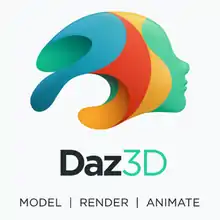Daz 3D
Daz Productions, Inc. (commonly known as Daz 3D, stylized Daz3D or DAZ 3D in some logos) is a 3D-content and software company specializing in providing rigged 3D human models, associated accessory content, and software to the hobbyist as well as the prosumer market. Originally a part of Zygote Media Group, a general purpose, application-agnostic broker of 3D content, Daz 3D split off as Digital Art Zone[1] in 2000[2] to focus on supplying content for the Poser market. The company no longer uses that name, and does not treat "Daz" as an acronym for it.[3]
 | |
| Type | Software and Content Developer |
|---|---|
| Founded | Utah (2000) |
| Headquarters | Salt Lake City, Utah, United States |
| Website | daz3d |
Daz 3D has continued to focus on 3D-content development, but has also expanded their own software offerings as well, with purchases of several notable 3D applications:
- Bryce, a fractal-based landscape modeler and renderer acquired from Corel by Daz 3D in 2004.[4]
- Hexagon, a 3D mesh modeler originally developed by Eovia, acquired by Daz 3D in 2006.[5]
- Carrara, a general purpose 3D modeler/animation package also acquired from Eovia in 2006.[6]
Additionally, Daz 3D developed their own scene creator software, Daz Studio,[7] as an alternative to Poser.[8]
In 2016, Daz 3D spun off Tafi, a 3D-content company intended to focus more on the game-developer market.[9]
Free 3D software
In 2012, Daz 3D shifted their strategy from selling 3D software and content to one of giving the software away for free[10] and focusing more on the selling of the content. This began with offering Daz Studio for free in 2012, which gave customers the ability to render images and video, and expanded in 2017 when Daz 3D added Hexagon to the list of their free software products and added the ability to do 3D modeling to that mix.
Figure technology
Daz 3D has had many versions of its human figures and characters, but in 2011 they launched a significant change in the underlying technology. Instead of each figure being designed individually, Daz 3D moved to their Genesis platform, in which figures were derived as morphs from the base mesh. Two of the key differences that this technology created were: the ability for characters to be blended into a huge variety of shapes; and, since these shapes were all derived from a common base, add-on content like clothing, hair, and additional morphs would not only work on all characters, but could actually change with the characters.[11]
The Genesis platform has gone through several versions since the launch in 2011:
Genesis 2
One of the shortcomings of the Genesis platform was that although it allowed extremely flexibility in the shape of characters and clothing, it also toned down some of the elements of what made a male or female figure unique. Genesis 2, released in 2013,[12] changed this by splitting the Genesis base figure into two separate base figures: Genesis 2 Male and Genesis 2 Female.
Genesis 3
Up until Genesis 3 the Genesis figures had been using TriAx Weight Maps, where many other industry platforms were using Dual Quaternion. This changed in Genesis 3, released in 2015,[13] to allow Daz 3D figures to be more compatible with other 3D software platforms as well as Game Development platforms.
Genesis 8
The jump in version naming from Genesis 3 to Genesis 8 was in order to address confusion in naming conventions. Although Genesis had reached its fourth version, most of the Daz 3D flagship characters were now on their eight versions. In order to avoid the confusion of Victoria 8 or Michael 8 being Genesis 4 characters, Daz 3D shifted the versioning of Genesis to match with the character versions.
Genesis 8 also included significant changes, including joint and muscle bends and flexing, and facial expressions. This resulted in reduced backward compatibility with previous generations' figures and their content.[14]
References
- Harvey, Tom (March 28, 2012). "Utah company counts on big giveaway to boost bottom line". The Salt Lake Tribune. Retrieved August 18, 2017.
- "Daz 3D Company Profile: Valuation & Investors". Pitchbook.com. Retrieved January 29, 2018.
- "Daz 3D [homepage]". Daz3D.com. Daz 3D. 2020. Copyright notice. Retrieved May 1, 2020.
Daz Productions, Inc., dba Daz 3D. Daz is a Registered Trademark of Daz Productions, Inc.
- "DAZ acquires Bryce from Corel". Retrieved January 29, 2018.
- "DAZ Productions Acquires Eovia US Corp.: Deal Bolsters DAZ's Commitment to High-quality, Affordable 3D Solutions and Ensures Solid Future for Eovia's Widely Acclaimed Software". Retrieved January 29, 2018.
- "DAZ acquires Carrara maker Eovia Corp". Macworld. Retrieved January 29, 2018.
- "DAZ Studio". PCWorld. Retrieved January 29, 2018.
- "Daz3d Studio Pro Review". NativeTelecom. January 18, 2018. Retrieved January 29, 2018.
- "Reality Revolution: Virtual reality is ready to take Utahns to new landscapes". UtahBusiness.com. Retrieved January 29, 2018.
- "Utah company counts on big giveaway to boost bottom line". The Salt Lake Tribune. Retrieved January 29, 2018.
- "Daz 3D introduces Genesis technology for 3D human models". GfxSpeak.com. Retrieved January 29, 2018.
- "Victoria 6". Daz 3D. Retrieved March 18, 2015.
- "DAZ 3D Announces Launch of Victoria 7" (Press release). Salt Lake City, Utah: Daz 3D. PRWeb. June 23, 2015. Retrieved June 15, 2017.
- "Review: Daz 3D's Victoria 8". DigiSprawl. June 20, 2017. Retrieved January 29, 2018.